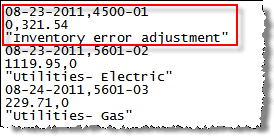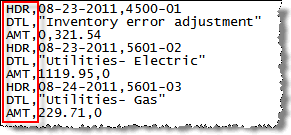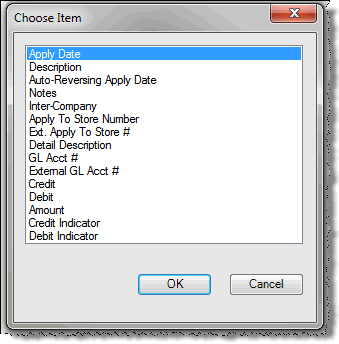Electronic Transmissions - Journal Entries

This screen allows you to configure a template that can be used to import
journal entries into Compeat from text files created by another accounting
system or source.
Once a template has been created, journal entries can be imported from
the Import Journal Entries (Templates) screen.
General

- Name This is the name of
the template. It is recommended you name the template for the
source or system you will be using the template for.
- Revision You can assign
a revision number to the template by entering the revision number
here. This allows you to create multiple templates in the system
for the same source or system, and keep track of them.
File Settings

In this section, you define the information about the journal entry
files you plan to import.
- File Type This sets the
basic file format type. There are 3 possible selections:
- Delimited
Fields of this type are separated by a character, such as a comma,
tab, or space. Files of this type will often have extensions such
as .txt, or .csv. Here's what the data in a delimited file
may look like:

- Fixed
Width In this type, fields are defined by a specific length
of characters. Files of this type may also have extensions of
.txt. Here's what the data in a fixed width file may look
like:

- Excel
Select for Excel spreadsheets.
- Header rows to skip Some
data files will have one or two header rows with column names. These
should not be included in the import. Specify the number of header
rows in your data file, and Compeat will remove this number of rows
from the imported data.
- Minimum Row Length Enter
the minimum number of characters that Compeat should consider as row
with valid data in the file. Rows in the file comprised of less
characters than the minimum amount will be ignored during the import
process. This is mainly used if the file contains section headings,
or other rows that do not contain JE data, that are shorter in length
than valid rows.
- Text Qualifier For delimited
data, specify the text qualifier used. Delimited data use a text qualifier
to specify a string of words as one field, even if it contains a delimiter.
Typical text qualifiers are single- or double-quotes. You can usually
determine what text qualifiers are used by opening your data file
in Notepad and examining the data.
- Field Delimiter For delimited
file types, specify the delimiter. Delimiters separate different fields
in a record (row). You can determine the delimiter type by opening
the file in Notepad, and look for column separators.
- Row Delimiter For fixed
width and delimited file types, select a row delimiter. Row delimiters
separate one record from another.
- Record Format Type This
indicates how the invoice data itself is formatted within the invoice
file. There are 3 possible selections:
- Single Row Per Record
Select this if all of the data for each single record in the file
is contained in one row of data. In this format, for example,
a single row in the file would contain the apply date,GL account
number, amount, and description. Here's what the data may
look like in a file with this data type:

- Fixed Number Of Rows
Select this if a single record in the file is comprised
of multiple rows. In this format, for example, one row of
the record may contain the GL account number and apply date. The
next row in the file may contain the description, and the row
after that may contain the credits and debits. Here's what the
data may look like in a file with this record type, where each
record is composed of 3 rows:

- Rows Contain A Record Indicator
Select this if the file contains a column containing a row indicator.
A row indicator is used to denote the type of data contained
in the row. For example, one row may contain a record indicator
of ‘HDR’, denoting that the row contains JE header information
such as the apply date, and GL account number. Another row
might have an indicator of ‘DTL’, indicating that the row contains
line-item detail information such as the description. Another
may have an indicator of ‘AMT’, indicating the row contains debits
and credits. What the indicators are and what they represent
may vary from source to source. When this format type is
selected, a box will appear labeled ‘Indicator Position’. Enter
the column number in the file that contains the row indicator.
For delimited and fixed-width files, the columns are numbered
left-to-right beginning with zero. For Excel files, the
column names are used (A, B, C, etc.). Here's what the data
may look like in a file that uses row indicators:

- New Record On
This tells Compeat when to begin a new journal entry, based on the
changing of information in the records. There are 3 options:
- Always
Compeat will create a new journal entry for each record in the
file.
- Apply
Date Compeat will create a new journal entry each time
it detects a change in the apply date in the records in the file.
- Description
Compeat will create a new journal entry each time it detects a
change in the description in the records in the file.
- Record
Indicator Compeat will create a new journal entry each
time it detects the record indicator you specify in the ‘New Rec.
Ind.’ Box. For example, if you want Compeat to create a
new JE each time a new header row is encountered, and in the file
the record indicator for header row is ‘HDR’, enter ‘HDR’ in the
box. The Record Indicator options only appear if ‘Rows contain
a record indicator’ is selected as the record type.
Field Definitions

The Fields section contains a data grid that is used to map fields from
the order guide to fields within Compeat. Click the plus symbol in the
grid toolbar to open a list of hard-coded Compeat fields.

Select the fields that you wish to map to and then click OK.
Note: The list of available fields may not exactly match
those in a data file. For example, a column named "Item ID"
in the data field may need to be mapped to the "Item Code" in
Compeat.
Description grid options:
- Field This field is non-editable
and can be selected from a list of hard-coded options by clicking
the plus symbol in the grid toolbar. This forms the list of Compeat
fields to be mapped to the order guide fields. In order to successfully
import the invoice file into Compeat, the following fields must be
defined: Apply Date, GL Account # or External Account #, Amount or
Credit and Debit, and Description. Some fields expect specific
values:
Debit
Indicator This field expects a true or false value, with the true
value indicating the amount in the record is a debit, and a false
value indicating a credit. In order for a true value to be detected,
the field must contain 'd' or 'debit'. For a false value to
be detected, it must contain 'c' or 'credit'. If the data in
the invoice file does not use one of these indicators, you can use
the 'REPLACE' formatting rule to replace the values in the file with
one of the accepted ones.
Credit
Indicator This field expects a true or false value, with the true
value indicating the amount in the record is a credit, and a false
value indicating a debit. In order for a true value to be detected,
the field must contain 'c' or 'credit'. For a false value to
be detected, it must contain 'd' or 'debit'. If the data in
the invoice file does not use one of these indicators, you can use
the 'REPLACE' formatting rule to replace the values in the file with
one of the accepted ones.
- Location Use this field
to indicate which column in the order guide should be mapped to this
Compeat field. Delimited and fixed-width columns are numbered
left-to-right, beginning with 0. For example if you wish to
map the Compeat field to the third column in the invoice file, enter
"2" in this field. For Excel files, the column names
are used (A, B, C, etc.).
- Length Specify the length
of the field for fixed-width data types. This field is not relevant
to other file types, and will only appear if ‘Fixed Width’ is selected
as the file type.
- Formatting Rules Shows
any formatting rules applied to the field. Double-click to create
or edit rules.
- Record Ind. This column
is visible when ‘Rows Contain A Record Indicator’ is selected as the
record format type. Enter the record indicator here to specify
what type of data the column contains in the indicated row.
- Row # This column is visible
when ‘Fixed Number Of Rows’ is selected as the record format
type. Enter the row number within the record here.
Formatting Rules
You can apply functions to transform the data as it is imported. To
create rules for a field, select the field and click on Edit Formatting
Rules. These rules include functions for concatenating, removing spaces,
converting case, basic math functions, and more. A brief description each
function will display at the bottom of the dialog when you click on the
function in the "Available Rules" list.

Import File Specifications
The Import Template and Export Template buttons can be used
to export the current configuration to an xml file or import an existing
configuration from an xml file.


![]()








